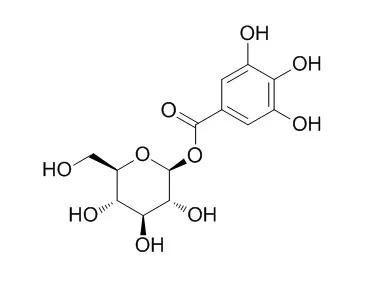| In vitro: |
| Chemico Biological Interactions, 2013, 202(1-3):283-287. | | Beta-glucogallin reduces the expression of lipopolysaccharide-induced inflammatory markers by inhibition of aldose reductase in murine macrophages and ocular tissues.[Reference: WebLink] | Aldose reductase (AR) catalyzes the reduction of toxic lipid aldehydes to their alcohol products and mediates inflammatory signals triggered by lipopolysaccharide (LPS). beta-Glucogallin (BGG), a recently described AR inhibitor, was purified from extracts of the Indian gooseberry (Emblica officinalis).
METHODS AND RESULTS:
In this study, we found that BGG showed low cytotoxicity in Raw264.7 murine macrophages and effectively inhibited AR activity as measured by a decrease in sorbitol accumulation. In addition, BGG-mediated inhibition of AR prevented LPS-induced activation of JNK and p38 and lowered ROS levels, which could inhibit LPS-induced apoptosis. Uveitis is a disease of the eye associated with chronic inflammation. In this study, we also demonstrated that treatment with BGG decreased the number of inflammatory cells that infiltrate the ocular media of mice with experimental uveitis.
METHODS AND RESULTS:
Accordingly, these results suggest BGG is a potential therapy for inflammatory diseases. | | Investigative Ophthalmology & Visual Science,2017,58:1177. | | Beta glucogallin, a plant-derived antioxidant and anti-inflammatory agent, alleviates corneal injury from chloropicrin exposure.[Reference: WebLink] | There are no effective therapies to alleviate corneal injury from chloropicrin (CCl3NO2, trichloronitromethane, CP) exposure, a broad spectrum fumigant and pesticide which has been employed as a warfare agent. CP exposure-induced eye injury is associated with lacrimation and inflammation which involves corneal edema and damage. Based on completed mechanistic studies, we tested the efficacy of beta-Glucogallin (BGG), a natural antioxidant and anti-inflammatory agent with anti-lipid peroxidation and carbonyl scavenger properties, hypothesized as an effective therapy against CP-induced corneal injury.
METHODS AND RESULTS:
Efficacy studies were carried out in primary human corneal epithelial (HCE) cells following 30 min exposure to 50 µM CP with and without treatment with either 50 µM BGG or a perfluorocarbon oxygen emulsion. Western blot analysis was assessed 24 h post exposure to determine the CP-induced effects on various molecular markers. CP injury was induced in ex vivo rabbit corneas by exposing the corneas to 200 nmol CP for 2 h, followed by washing and treatment with 10 µl of 500 µM BGG and thereafter every 6 h for 24 h. Corneal tissue was prepared for subsequent histological (H&E staining), immunohistochemical, and western blot analyses. In primary HCE cells, BGG treatment reduced CP-induced increases in cleaved PARP by 35%, H2A.X phosphorylation by 40%, MAPK-JNK phosphorylation by 43%, protein carbonylation (biotin hydrazide) by 56%, and a complete reversal in lipid peroxidation (4-hydroxynonenal, 4-HNE). Preliminary studies in HCE cells indicate that application of the oxygen emulsion reduced CP-induced phosphophorylated-p53 and cleaved PARP. In ex vivo rabbit corneas, BGG treatment resulted in a 31% reversal in CP-induced epithelial degradation and complete reversal in CP-induced COX-2 expression and protein carbonylation.
CONCLUSIONS:
These data suggest strong potential for BGG in reversing CP-induced lipid peroxidation and protein carbonylation as well as reducing epithelial degradation and inflammation in rabbit cornea when given 2 h after CP exposure. Further studies expanding the examination of BGG alone or in combination with oxygen emulsion in alleviating CP- and other chemical agents-induced ocular injury, and delineation of its targets and pathways is justified. |
|






 Cell. 2018 Jan 11;172(1-2):249-261.e12. doi: 10.1016/j.cell.2017.12.019.IF=36.216(2019)
Cell. 2018 Jan 11;172(1-2):249-261.e12. doi: 10.1016/j.cell.2017.12.019.IF=36.216(2019) Cell Metab. 2020 Mar 3;31(3):534-548.e5. doi: 10.1016/j.cmet.2020.01.002.IF=22.415(2019)
Cell Metab. 2020 Mar 3;31(3):534-548.e5. doi: 10.1016/j.cmet.2020.01.002.IF=22.415(2019) Mol Cell. 2017 Nov 16;68(4):673-685.e6. doi: 10.1016/j.molcel.2017.10.022.IF=14.548(2019)
Mol Cell. 2017 Nov 16;68(4):673-685.e6. doi: 10.1016/j.molcel.2017.10.022.IF=14.548(2019)